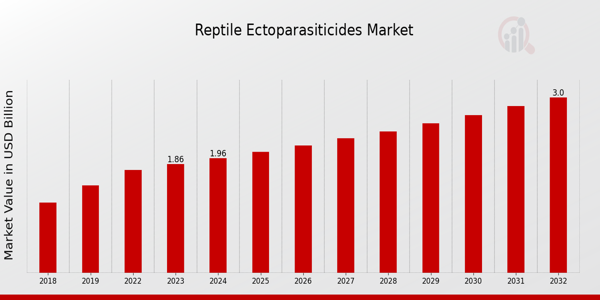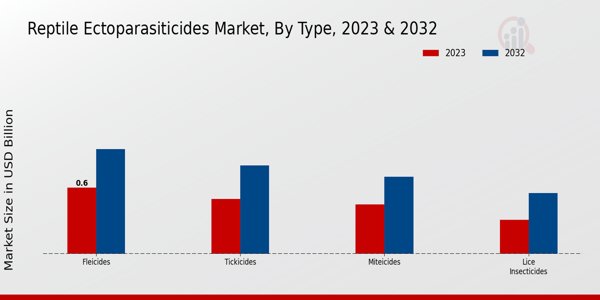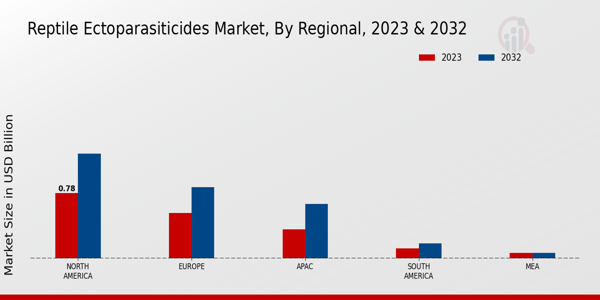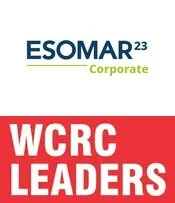Reptile Ectoparasiticides Market Overview
As per MRFR analysis, the Reptile Ectoparasiticides Market Size was estimated at 2.07 (USD Billion) in 2024. The Reptile Ectoparasiticides Market Industry is expected to grow from 2.18 (USD Billion) in 2025 to 3.52 (USD Billion) till 2034, at a CAGR (growth rate) is expected to be around 5.48% during the forecast period (2025 - 2034).
Key Reptile Ectoparasiticides Market Trends Highlighted
The Reptile Ectoparasiticides Market is experiencing significant growth driven by increasing pet ownership and the rising awareness of health and hygiene among pet owners. As reptiles such as snakes, lizards, and turtles become more popular as pets, the need for effective ectoparasiticides grows. Pet owners are increasingly concerned about the well-being of their animals and the potential health risks posed by ectoparasites, such as mites and ticks. This demand for safe and effective ectoparasiticides fuels innovation and product development within the market, leading companies to focus on creating more specialized formulations that cater to the unique needs of different reptile species.In this market, there are many possibilities for growth, specifically in developing regions where the ownership of reptiles is increasing. By focusing the products more exclusively on certain types of reptiles or certain types of environments, manufacturers can also aim for niche markets. Moreover, the upward trend of natural and eco-friendly products is also an opportunity. People are looking for safer and non-toxic options, and companies that will provide biodegradable and eco-friendly formulations will be in a good position. Recent research suggests, however, that there is a growing preference for online stores, and the pet product market is going the same way as any other.Social media and digital marketing also play a crucial role in raising awareness about the importance of ectoparasiticides and promoting new products. The increasing emphasis on preventive healthcare in reptiles shows a growing understanding among pet owners of the necessity to act before infestations occur. Overall, these market dynamics present a favorable environment for businesses in the Reptile Ectoparasiticides Market to thrive and innovate.

Source: Primary Research, Secondary Research, MRFR Database and Analyst Review
Reptile Ectoparasiticides Market Drivers
Increasing Pet Ownership and Exotic Animal Keeping
The rising trend in pet ownership, especially exotic pets like reptiles, is a significant driver for the Reptile Ectoparasiticides Market Industry. As more individuals are drawn to keeping reptiles as pets, the demand for suitable care products, including ectoparasiticides, has surged. Pet owners are becoming more attuned to the particular needs of reptiles, recognizing the importance of maintaining their health and well-being. This increased awareness of pet health promotes spending on specialized products designed to treat or prevent ectoparasitic infections.The market has witnessed a notable transformation where reptile enthusiasts actively seek high-quality, effective treatments to ensure their pets are protected against parasitic threats. Consequently, a larger customer base leads to the expansion of distribution channels and product availability, further stimulating market growth. Additionally, as people become more aware of the health risks posed by ectoparasites, not only to reptiles but also to themselves and their family members, the demand for efficacious treatments grows.This dynamic interaction between pet ownership trends and health consciousness creates a more robust market environment, encouraging innovation and expansion within the Reptile Ectoparasiticides Market Industry.
Advancements in Formulation and Technology
Innovations in the formulation and delivery of ectoparasiticides play a crucial role in the Reptile Ectoparasiticides Market Industry. Manufacturers are focusing on developing new active ingredients that are effective yet safe for reptiles. Enhanced delivery systems such as sprays, spot-ons, and oral treatments are being designed to increase efficacy and ease of application. These advancements not only improve the effectiveness of ectoparasiticides but also encourage more pet owners to utilize them, boosting sales and enhancing the overall growth of the market.Furthermore, ongoing research into eco-friendly alternatives is shaping product development as consumers are increasingly interested in sustainable and safe options for their pets.
Rising Awareness of Ectoparasitic Threats
The growing awareness of ectoparasitic threats among reptile owners significantly influences the Reptile Ectoparasiticides Market Industry. As pet owners educate themselves more about the potential health risks posed by parasites, the demand for effective treatment options increases. This heightened awareness drives not only consumer demand but also the importance of educating pet shops and veterinary clinics about appropriate treatment methods.The market consequently responds to these factors by offering more diverse products tailored to combat ectoparasitic threats effectively.
Reptile Ectoparasiticides Market Segment Insights
Reptile Ectoparasiticides Market Type Insights
The Reptile Ectoparasiticides Market is characterized by its diverse array of Type segments, which includes Fleicides, Tickicides, Miteicides, and Lice Insecticides. In 2023, the overall market was valued at 1.86 USD Billion, with each segment accommodating various pest control needs among reptiles. Fleicides emerge as a significant player within this market, holding a valuation of 0.6 USD Billion in 2023, and is projected to increase to 0.95 USD Billion by 2032. This segment dominates due to the heightened prevalence of flea infestations in reptilian pets and the growing awareness among reptile owners regarding regular parasite control. Tickicides also play an essential role, with a market value of 0.5 USD Billion in 2023, set to rise to 0.8 USD Billion in 2032. The significance of this segment stems from the critical threat ticks pose to reptile health, which drives demand for effective treatments. Miteicides are similarly crucial, valued at 0.45 USD Billion in 2023 and expected to reach 0.7 USD Billion by 2032. The growing incidence of mite infestations, particularly in captive reptiles, contributes to the increasing market growth in this category. Lice Insecticides, while valued at a relatively lower 0.31 USD Billion in 2023 and anticipated to grow to 0.55 USD Billion by 2032, still represent a vital segment as lice can lead to severe health issues and discomfort in reptiles, consequently affecting their owners’ experiences.Overall, the Reptile Ectoparasiticides Market data emphasizes the importance of understanding each Type segment’s specific characteristics and market dynamics. The steady growth across these segments reflects an increasing focus on reptile health and the rising trend of pet ownership, which further drives the market’s resilience and potential expansion within the industry. The growth drivers include increased awareness around reptile parasite management and advancements in ectoparasiticides technology, while challenges may arise from regulatory hurdles and market competition. The segment's statistics tell a compelling story of a growing awareness of reptile care and the preventative health measures being implemented by pet owners, ensuring a robust market trajectory in the coming years.

Source: Primary Research, Secondary Research, MRFR Database and Analyst Review
Reptile Ectoparasiticides Market Formulation Insights
The Reptile Ectoparasiticides Market, valued at 1.86 billion USD in 2023, showcases a diverse range of formulations designed to combat ectoparasites affecting reptiles. This market features several forms, such as liquid, powder, spray, and drench, with liquid formulations often dominating due to their ease of application and effectiveness. Powder formulations provide a concentrated solution that can be effective for prolonged periods, essential in environments where sustained protection is required. Spray formulations are favored for their convenience and rapid application, catering to both commercial and private reptile owners.Drench formulations, while less common, serve an important role in treating larger infestations and are particularly effective in ensuring thorough coverage. Each formulation type addresses specific user needs and preferences, making the Reptile Ectoparasiticides Market segmentation distinct and adaptable to the evolving challenges in reptile health management. The growth drivers for this segment include increasing pet ownership and the rising awareness of reptile infestations, supported by relevant Reptile Ectoparasiticides Market data indicating robust market growth.As the market trend leans towards more user-friendly and effective formulations, opportunities continue to expand within this niche industry.
Reptile Ectoparasiticides Market Distribution Channel Insights
The Reptile Ectoparasiticides Market, valued at 1.86 billion USD in 2023, exhibits a diverse range of distribution channels that cater to various consumer needs and preferences. Notably, the online channel has gained substantial traction, allowing customers to easily access a wide range of products from the comfort of their homes. Retail outlets also play a critical role, providing significant visibility and immediate access to reptile owners. Veterinary clinics are pivotal, as they not only offer treatments but also educate pet owners on pest control, highlighting their importance in the segment.Specialty stores, recognized for their tailored offerings, dominate a substantial share of the market, attracting dedicated reptile enthusiasts seeking specific ectoparasiticides. Together, these channels reflect the Reptile Ectoparasiticides Market segmentation and robust landscape, contributing to continued market growth. The evolving trends of online shopping and increasing awareness about reptile care further drive opportunities across these diverse distribution avenues, enhancing access and education. Meanwhile, effective marketing in these varied channels presents both challenges and opportunities in capturing consumer attention and loyalty within the Reptile Ectoparasiticides Market industry.
Reptile Ectoparasiticides Market Application Insights
The Reptile Ectoparasiticides Market, valued at 1.86 billion USD in 2023, exhibits significant growth within the Application segment, encompassing Home Use, Commercial Use, and Veterinary Use. The increasing pet ownership and the rising need for effective pest control solutions are driving demand in the home-use category, where consumers seek products that ensure the health and safety of their reptiles. Commercial Use applications, particularly in zoos and pet stores, also dominate due to the necessity of maintaining animal welfare standards and managing ectoparasites effectively.Veterinary Use remains crucial, as professionals require specialized products to treat infested reptiles, thus emphasizing the importance of product effectiveness and safety. The market growth is supported by trends such as the increased awareness of reptile health and well-being, creating a landscape filled with opportunities for innovation and development within this segment. However, the sector may face challenges like regulatory hurdles and competition among brands, necessitating continuous research and development to address these issues effectively, which is vital for maintaining the integrity and revenue of the Reptile Ectoparasiticides Market.
Reptile Ectoparasiticides Market Regional Insights
The Reptile Ectoparasiticides Market demonstrates considerable variation across its regional segmentation, reflecting diverse market dynamics. In 2023, North America leads the market with a valuation of 0.78 USD Billion, projected to grow to 1.25 USD Billion by 2032, showcasing its majority holding in the industry due to high demand for reptile care products. Europe follows with a valuation of 0.54 USD Billion in 2023 and is expected to reach 0.85 USD Billion by 2032, indicating the region's significant interest in pet reptiles and their health management.The APAC market, valued at 0.35 USD Billion in 2023, is poised for growth to 0.65 USD Billion by 2032, underscoring the rising popularity of exotic pets. In contrast, South America, with a value of 0.12 USD Billion in 2023 projected to reach 0.18 USD Billion in 2032, and MEA, which remains at 0.07 USD Billion throughout the period, represents the smaller segments, reflecting lower penetration and awareness. Overall, the market reveals distinct regional patterns driven by pet ownership trends, healthcare awareness, and economic conditions, alongside the Reptile Ectoparasiticides Market Statistics that emphasize these growing opportunities worldwide.

Source: Primary Research, Secondary Research, MRFR Database and Analyst Review
Reptile Ectoparasiticides Market Key Players and Competitive Insights
The Reptile Ectoparasiticides Market represents a dynamic sector within the global agrochemical industry, focusing on the control and management of pests affecting reptiles. This market is characterized by numerous players striving to address the specific needs of reptile care, thereby presenting a competitive landscape heavily reliant on innovation, regulatory compliance, and product efficacy. Key factors influencing competitiveness in this market include advancements in formulation technologies, growing awareness of reptile health, and increasing demand for eco-friendly solutions. Stakeholders are also adjusting strategies to align with evolving consumer preferences, emphasizing the importance of effective marketing, distribution networks, and customer education in establishing a strong market footprint.Bayer stands as a prominent player in the Reptile Ectoparasiticides Market, leveraging its extensive research and developmental capabilities to introduce innovative products that effectively target ectoparasites. The company's strength lies in its strong brand recognition and established reputation for quality and efficacy in pest control. Bayer’s commitment to scientific research enables the development of cutting-edge formulations that not only provide effective solutions for reptile owners but also comply with stringent regulatory standards. Additionally, Bayer's expansive distribution network and strategic partnerships enhance its market presence, allowing it to reach a diverse customer base while providing continued support through education and product training.James F. Murphy, while perhaps less prominent than some larger competitors, has carved out a niche for itself within the Reptile Ectoparasiticides Market through its specialized focus on products tailored for reptile enthusiasts. The company is recognized for its innovative approaches and high-quality formulations that meet the unique needs of reptile care. James F. Murphy benefits from its deep understanding of reptile biology and the specific challenges posed by ectoparasites, which informs the development of effective solutions. Their market strategy often emphasizes customer relationships and specialized service, which help build loyalty among a dedicated consumer base passionate about reptile care. This customer-centric approach, combined with a focus on education and outreach, positions James F. Murphy favorably within the competitive landscape of reptile ectoparasiticides.
Key Companies in the Reptile Ectoparasiticides Market Include:
Reptile Ectoparasiticides Market Industry Developments
The Reptile Ectoparasiticides Market has seen significant activity lately, driven by emerging trends and increasing attention towards reptile care. Companies such as Bayer, Merck Animal Health, and Zoetis have been focusing on the development of new formulations aimed at controlling external parasites effectively while ensuring the safety of reptiles. There has been notable growth in the market valuation of specialized products, reflecting rising consumer awareness and demand for effective ectoparasiticides. Furthermore, acquisition activities have gained momentum, with several companies in the market looking to strengthen their portfolios. For instance, the collaboration between Virbac and Havard Bioscience signifies a strategic move towards enhancing research capabilities in ectoparasiticides for reptiles. Meanwhile, Scott's Miracle-Gro and Elanco continue to explore innovations that cater specifically to the needs of reptile enthusiasts. The efforts by Nufarm and Pest Control Technologies to expand distribution channels emphasize the competitive landscape of the market, which is expected to evolve further as companies strive to meet the challenges posed by ectoparasites in reptiles. Overall, the Reptile Ectoparasiticides Market is on a trajectory of growth, bolstered by advancements in product offerings and strategic partnerships.
Reptile Ectoparasiticides Market Segmentation Insights
-
Reptile Ectoparasiticides Market Type Outlook
-
Fleicides
-
Tickicides
-
Miteicides
-
Lice Insecticides
-
Reptile Ectoparasiticides Market Formulation Outlook
-
Liquid
-
Powder
-
Spray
-
Drench
-
Reptile Ectoparasiticides Market Distribution Channel Outlook
-
Online
-
Retail
-
Veterinary Clinics
-
Specialty Stores
-
Reptile Ectoparasiticides Market Application Outlook
-
Home Use
-
Commercial Use
-
Veterinary Use
-
Reptile Ectoparasiticides Market Regional Outlook
-
North America
-
Europe
-
South America
-
Asia Pacific
-
Middle East and Africa
| Report Attribute/Metric |
Details |
|
Market Size 2024
|
2.07 (USD Billion)
|
|
Market Size 2025
|
2.18 (USD Billion)
|
|
Market Size 2034
|
3.52 (USD Billion)
|
|
Compound Annual Growth Rate (CAGR)
|
5.48 % (2025 - 2034)
|
|
Report Coverage
|
Revenue Forecast, Competitive Landscape, Growth Factors, and Trends
|
|
Base Year
|
2024
|
|
Market Forecast Period
|
2025 - 2034
|
|
Historical Data
|
2020 - 2024
|
| Market Forecast Units |
USD Billion |
| Key Companies Profiled |
Bayer, James F. Murphy, Virbac, Merial, Scott's MiracleGro, Zoetis, Havard Bioscience, Merck Animal Health, Nufarm, Pest Control Technologies, Elanco, Boehringer Ingelheim, Piramal Enterprises, Cegelec |
| Segments Covered |
Type, Formulation, Distribution Channel, Application, Regional |
| Key Market Opportunities |
Rising pet ownership trends, Increased awareness of reptile health, Innovative product formulations, Growing online retail platforms, Expansion in emerging markets |
| Key Market Dynamics |
rising pet ownership, increasing awareness of health, regulatory compliance pressures, demand for eco-friendly solutions, technological advancements in formulations |
| Countries Covered |
North America, Europe, APAC, South America, MEA |
Frequently Asked Questions (FAQ) :
The Reptile Ectoparasiticides Market is expected to be valued at approximately 1.96 USD Billion in 2025.
The market is projected to have a CAGR of 5.48% from 2025 to 2034.
North America is expected to hold the largest market share, valued at 1.25 USD Billion by 2034.
The European market is anticipated to grow to approximately 0.85 USD Billion by 2034.
Fleicides are valued at 0.6 USD Billion in 2023 and are expected to reach 0.95 USD Billion by 2034.
Key players in the market include Bayer, Virbac, Zoetis, and Merck Animal Health, among others.
The market size for Tickicides is expected to reach 0.8 USD Billion by 2034.
Miteicides are expected to contribute approximately 0.7 USD Billion to the market by 2034.
The South American market is expected to increase to around 0.18 USD Billion by 2034.
The growth of the market may face challenges such as regulatory changes and environmental concerns regarding pesticide use.















